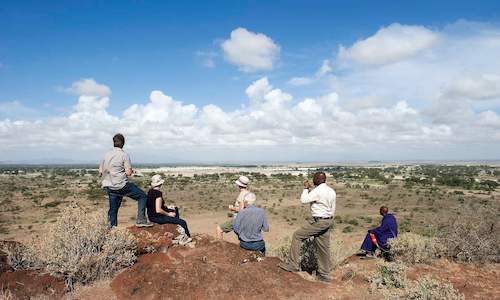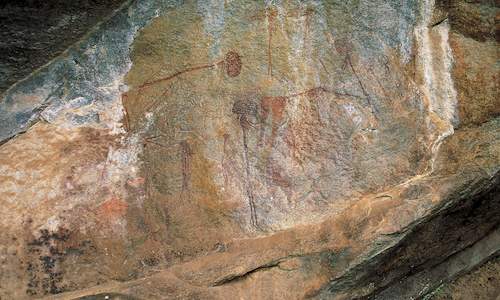


We visit two small mud huts where two widows live with their seven children. Part of the funds from the cultural tours will go towards paying for their education. Another beneficiary is the local school where funds are used to buy desks and build new classrooms for the 530 children.After a healthy lunch of carrots, rice, spinach and cooked bananas, deliciously prepared by Lightness and her womens group, we ascend the lower slopes of Mount Meru, a dormant volcano that last erupted over 100 years ago.
We're soon enveloped by the sounds and silence of the forest. A big blue monkey bolts up a fifty foot tree from where he peers inquisitively at us before swinging through the air to another branch. We continue up the hillside until we arrive at a giant fig tree where smoke curls up from a clearing in the bushes. Paolina the medicine woman is busy cooking up a potful of plants.'If people are sick, they come to me and I make them better. I love my work,' she says shyly, offering me a swig from the sweet brew of bark, berries, herbs and leaves.For thousands of years, traditional healers in the area have used herbs and plants to cure illnesses such as measles, mumps, malaria, pneumonia, diarhoea, sore joints, back ache, fever and pregnancy problems.It's getting late and we've still got a long drive ahead to the Mkuru camel camp. We leave the main road and head along a rough and tumble track towards Arusha National Park. It's only 40 kilometres to Mkuru but with the state of the road, it's almost a three hour drive. Huge plumes of dust envelop our 4x4 as we pass fields of onions and beautiful acacia trees.We zig zag around large boulders, stopping to watch buffalo, zebra and Tanzania's national animal, the giraffe. We arrive too late for a safari, but just in time to watch the camels being milked. Over a hundred camels are kept in the camp and every day, the Maasai lead them into the plains to search for forage. In the afternoon, they return and are milked by the warriors.The next morning I'm up before sunrise. The horizon is just starting to tinge pink over a giant acacia tree and two Maasai warriors are stoking up the fire. There's not a breath of wind and the only sound is the twittering of birds in the still African dawn.Before breakfast, Miet and I go for a short hike in the woodlands surrounding the camp. This is part of the wildlife corridor between Amboseli National Park in Kenya and Arusha National Park, where game can occasionally be spotted from a distance. We cross a dried up river bed and walk beneath giant cacti and shady trees. In the distance, Mount Meru plays hide-and-seek in the clouds.The beauty of the bush astounds me. 'Do you think there are any wild animals around here?' I ask Miet, but before I can finish the sentence, I suddenly catch sight of a brown jackal slinking through the veld. In Mkuru, part of the proceeds from the camel tours go towards building a kindergarten. Before we leave, Pelo the chief takes us to see the wooden framework of the school.'There is no primary school in Mkuru so the children have to walk long distances to neighbouring villages,' explains Miet. 'But for the very young it is too far to go, so they need a kindergarten here to begin their education.'We head on eastwards, past the picturesque town of Moshi to the coffee-growing area around Marangu. Nestling in the foothills of Mount Kilimanjaro, Marangu's mountain scenery is pure magic. Several walking trails take the nature lover down deep green gorges to spectacular waterfalls and through the interesting villages of the Chagga people.Our local guide is Dixon Mambaly who welcomes us with a warm smile. ''Jambo' .. 'habari', I am sure you will find Marangu very interesting.' Dixon is clearly passionate about the cultural awakening among tourists and isn't afraid to speak his mind.'Most visitors fly in here, climb Kili, get to the summit, then go home. Their friends ask them what the people and the country are like but they cannot really answer. That isn't right. They should learn about our land.'For Dixon and his community, the tours are already starting to pay dividends. 'We must thank 'mamma' Mietie because she's given us lots of encouragement,' he says excitedly. 'A group of Americans have just been here for a week, especially to see the cultural tours in the area after reading about it on the Internet. On their last day, they handed over more than $1000 worth of books, encyclopedias, paints, stationery and cash to our secondary school.'We watch the traditional blacksmiths bang out spears and tools to be sold to the Maasai. Then in the hot midday sun, Dixon leads us through fields thick with coffee trees to visit a traditional Chagga thatched house. Most of the Chagga settlements have hidden passageways and caves running underground. These secret tunnels date back 400 years to the wars against the Maasai where the caves provided refuge for the Chagga.
I climb down the ladder into the darkness and count myself lucky that I don't suffer from claustrophobia. The winding tunnel is dark and humid and in several places, I'm forced onto hands and knees. Some larger caves and cooking areas open off the tunnel but after ten minutes, I'm ready for some fresh air.It's a full afternoon and first we pay a visit to the Mengeni Primary School where the children welcome us in their pretty floral garden with a bright burst of song. Next on the agenda is a hike to the Moonjo waterfall. But on the way, we stop to watch a young boy work the coffee machine, a hand pulper that skims the outer skin off the freshly picked coffee beans before they are laid out to dry.We trek down the steep and narrow goat path where one wrong foot could spell disaster. But it's worth the effort because down in the lush green valley, the Whona River is flowing fast. Just upstream, we rest in the spray of the magnificent Moonjo waterfall, cascading from the peaks above. For sunset we climb Ngangu Hill, from where you can gaze at unrivalled views of snow-capped Mount Kilimanjaro. Unfortunately the mighty mountain is covered in cloud so instead we turn and look out onto Kenya.Our last destination is deep in the Usambara Mountains. After a five hour drive, we arrive high in the hills of Lushoto. Set in a valley at 1200m, Lushoto is a big fruit-growing area and the Wasambaa farmers produce most of Tanzania's plum and pear crops. The Usambaras have one of the highest degrees of biodiversity in Africa and are famous for the Usambara or African violet.The mountain terrain is majestic. Fertile terraced hillsides fall away into green valleys with sparkling rivers. We stop to visit the Mhelo Primary School where the pupils proudly sit and smile at me from their new wooden desks. Then it's up the high Kwamongo Mountain, famous for its multi-coloured butterflies, to visit the tiny village of Shashui.Shrouded in mist and seldom visited by travellers, Shashui seems forgotten in time. Cattle graze around the small mud hut where a family welcome me into their modest home. Suddenly their attention is distracted by the sound of sobbing drifting across from a neighbouring hut. An old man who has been ill has just died.Then, strangely, the mist suddenly breaks and a weak sun comes through. By the time we get back to Lushoto, it's almost time for sunset. The village is buzzing with life. A soccer match is in progress on the field while up in huts, mothers are preparing the evening meal. Small children greet me from clay doorways. 'Jambo .. jambo,' they chant, welcoming me to their world.The next day, as we descend the steep rocky road, the cool climate of the Usambara Mountains gives way to a tropical warmth. I'm enjoying the sun seeping back into my body but I'm aware that the journey is coming to an end. I find myself missing the Maasai. So my thoughts turn to Pelo and I try to imagine what he's doing right now.Maybe measuring wood for the kindergarten. Or leaning on his stick as he leads the goats down the path. But probably wrapped in his red blanket, smiling a toothy grin as he milks a camel on the dusty Mkuru plain.
 This classic 3 day Kilimanjaro tour offers a glimpse of Tanzania and in-depth interaction with the culturally-unique Masai people as you nav...
This classic 3 day Kilimanjaro tour offers a glimpse of Tanzania and in-depth interaction with the culturally-unique Masai people as you nav... Better known for its wilderness areas, Tanzania nonetheless provides a rich cultural and historical aspect. Aside from the Ngorongoro Conser...
Better known for its wilderness areas, Tanzania nonetheless provides a rich cultural and historical aspect. Aside from the Ngorongoro Conser...